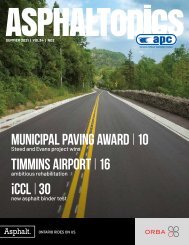ASPHALTopics | Spring 2020 | VOL 33 | NO 1
You also want an ePaper? Increase the reach of your titles
YUMPU automatically turns print PDFs into web optimized ePapers that Google loves.
A. SURFACE PREPARATION FOR NEW PAVEMENT<br />
Subgrade preparation is critical as all pavement structures<br />
are supported on the subgrade regardless of the surfacing.<br />
In traditional flexible pavements, a significant portion of the<br />
structural capacity is derived from the granular. So before<br />
paving with asphalt pavement, it is essential to ensure that:<br />
• Proper, consistent and uniform compaction have been<br />
achieved on the subgrade and granular subbase and base<br />
layers according to OPSS.501;<br />
• If soft wet subgrade is encountered, over-excavation of<br />
subgrade or stabilization solutions should be considered<br />
including the use of geosynthetics (geotextiles);<br />
• The granular subbase and base layers are strong enough<br />
to support construction traffic after rainfall without shoving,<br />
rutting or rolling — allowing sufficient time to dry prior to<br />
paving is critical as paving on a soft wet surface may result<br />
in blistering, delamination, and improper smoothness; and<br />
• Consideration is given to the use of a prime coat application<br />
on the compacted base layer to protect against moisture and<br />
provide better bonding between asphalt surfacing and the base<br />
layer — improper bonding can result in rutting in the sublayers<br />
which translates into fatigue cracking on the surface HMA.<br />
The emulsion must penetrate the<br />
first few millimeters of the layer<br />
very quickly.<br />
Prime coat will not succeed if the<br />
emulsion is of a viscosity that<br />
does not correspond to the gravel<br />
or has too high a breaking speed.<br />
Figure 1: Proper application of<br />
prime coat (www.roadresource.org)<br />
Figure 2: Performance of bonded vs. unbonded HMA<br />
(www.roadresource.org)<br />
B. SURFACE PREPARATION FOR OVERLAYING<br />
EXISTING STRUCTURES<br />
The first step before preparing tenders for overlaying<br />
existing pavements is to conduct a visual investigation<br />
of the candidate section. The goal of the investigation<br />
is to identify the state and type of distresses<br />
in the existing surface, and make appropriate<br />
recommendations.<br />
• Identify and make recommendations to address/<br />
repair localized areas of severe distress. Extreme<br />
surface damage usually reflects structural or<br />
drainage problems in the sublayers. If not fixed,<br />
the distresses can make their way into the newly<br />
placed surface in a very short time.<br />
• Determine whether a levelling course is warranted<br />
or if part of the existing surface should be milled to<br />
ensure consistent thickness and smoothness of the<br />
overlay.<br />
• In the case of overlaying a highly deteriorated<br />
concrete pavement, localized repairs would not be a<br />
feasible option. Rubblization of the existing concrete<br />
surface should be considered. This approach changes<br />
the distressed slabs to a stiff flexible base layer that<br />
eliminates reflective cracking and slab faulting.<br />
• Clearly describe proper cleaning techniques<br />
(mechanical brush or air blow) of the existing<br />
surface in the contract documents. Improperly<br />
cleaned surfaces result in lack of bond and shoving<br />
of the newly-placed surface.<br />
• Include the application of tack coat under the first<br />
lift and between subsequent lifts to ensure layers are<br />
bonded. This increases the strength of the pavement<br />
and increases the resistance to rutting deformations.<br />
The type of emulsion and rate of application should be<br />
in accordance with OPSS.308.<br />
According to a survey conducted by the Ontario Good<br />
Roads Association, only 67 per cent of municipalities specify<br />
and require the use of tack coat in their paving projects.<br />
Achieving the best layer interaction by taking all the above<br />
measures is one of many factors that guarantees longer<br />
service life and more return on the infrastructure investment.<br />
Whether it is a new pavement construction, or overlay on<br />
an existing structure, making sure that adequate surface<br />
preparation is included in the planning and tendering is key<br />
to successful paving results.<br />
James Smith is Manager, Member/Technical Services<br />
and Amin Mneina is Member Services Coordinator for<br />
the Ontario Good Roads Association.<br />
SPRING <strong>2020</strong> 29

















